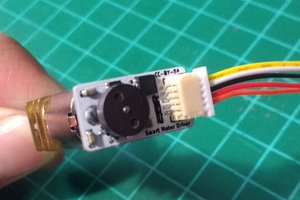The Turtle benefits of two important improvements compared to many similar projects like
https://hackaday.io/project/581-tiny-robot-family
1) the shaft of the motor is only 1mm and the motor is inclined by less than 30 degrees.
Even with 1mm "wheel", the speed with a motor spinning at 12000 RPM will be 60cm/second, 20 times the robot length, rather fast for a small animal. With larger "wheels" and PWM or on-off control, no hope to get a good behaviour.
2) the motor is controlled by PFM, allowing very slow speed. With the same motor, speed can be 1mm per second.
What is PFM? see http://www.didel.com/PFMversusPWMforRobots.pdf
At power-up, the Turtle a waits for IR control of for actions on the push-button.
IR control uses a 3-channel proportional scheme successful in 2005 for less-than-10 grams indoor flying models. It is easy to implement on Arduino http://www.didel.com/Ir/RolloverControlWithArduino.pdf
On the Turtle, decoding is made with a state machine. Synchronous programming handles the PFM in parallel.
Ballet demos are list of bytes that look like micro-controller instructions. One instruction sets the speed of the 2 motors (3 positive and 3 negative speed per motor) and the 2 possible duration of movement. Other instructions makes the robot spin at partial and full speed. More behaviors are programmed (it is more fun that writing a ballet!).
Ask for documentation if you read french.
The software uses less than 700 instructions. Ballets fill the rest of the 1K Microchip PIC 16F630.
 nicoud jean-daniel
nicoud jean-daniel

 Vipin M
Vipin M

 Artur Majtczak
Artur Majtczak
 Danny FR
Danny FR
What/Where is the SmileNG IDE? New to me ... Do you have docs on the setup of your toolchain?